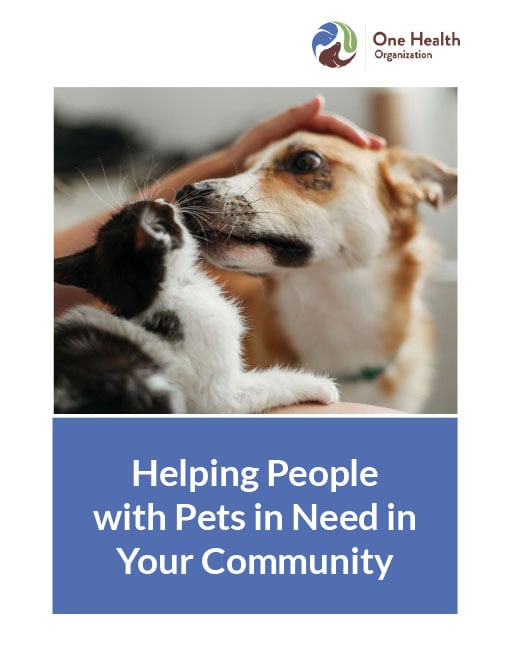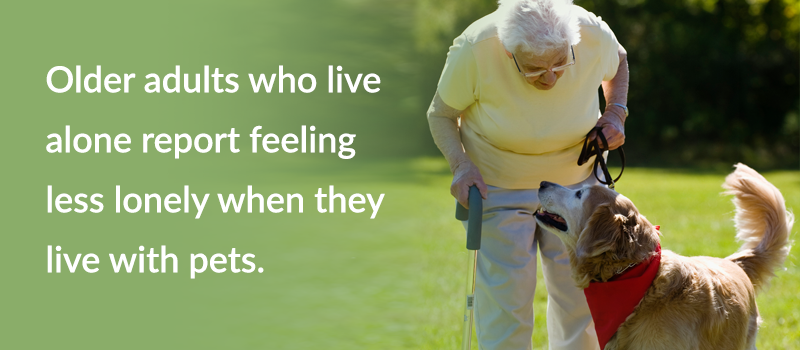Helping People with Pets in Need in Your Community
If you are a pet parent, you know how important your relationship with your animal is. We can’t imagine life without these companions. But significant social and economic barriers exist that prevent some people from being able to have these healthy relationships in their lives.
This is a guide to pet ownership as a social justice issue, covering the importance of pets for our mental and physical health, the growing movement to keep pets and people together, and ways you can get involved in your community.
Why Pets Are Important
For some pet parents, animals are even more than companions or family members. Some people rely on them to support their mental and physical health. Oftentimes, people who need their pets the most also need financial support.
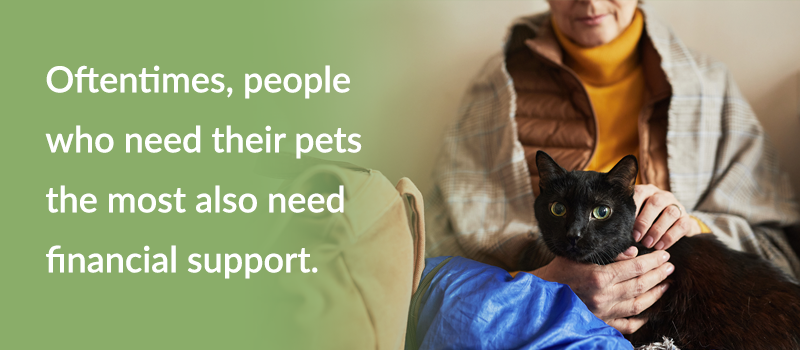
What are some of the roles animals play in our lives?
Special Relationships with Animals
- Companions/family members. For many people, an animal is more than a cherished companion that provides comfort. They’re a unique family member giving them that feeling of unconditional love. Scientists have also uncovered many physical and mental health benefits to living with companion animals.
- Service animals. A service animal is defined by the Americans with Disabilities Act (ADA) as a dog or miniature horse that is trained to do specific tasks that assist a person with disabilities.
- Emotional support animals (ESAs). Most pets provide some form of emotional support to their people, but ESAs are “prescribed” by getting a letter from a qualified doctor or mental health professional who determines that an animal can help you cope with conditions such as anxiety, depression, learning disabilities, attention deficit disorder, post-traumatic stress disorder, or chronic stress. The ADA’s definition of a service animal only includes dogs and miniature horses, but any animal can be designated an emotional support animal (ESA).
- Therapy animals are creatures (most often dogs) that are trained to provide comfort and support to people other than their own family members. Sometimes therapy animals visit schools, hospitals, nursing homes, rehab centers, or other institutions. Therapy animals need to be evaluated by veterinarians and trained by an animal‑assisted intervention organization. Sometimes their owners handle them, and other times they have a professional handler. But unlike service animals, they are not recognized by federal law under the ADA. Animal-assisted therapy is effective in treating PTSD, anxiety, and depression.
There are different sets of rules for travel, housing, and where you can bring animals, depending on their role. Service animals are welcome almost anywhere their person goes, but there are limitations for therapy animals and ESAs.
Download this guide as a PDF
Pets and Mental Health
Living with pets provides joy, comfort, and companionship — and that is good for us.
Have you noticed your pet showing you extra love when you’re sad? Pets can help us manage stress, anxiety, and depression. Their reliance on non-verbal communication and intuition is what makes them great support and therapy animals. That’s why animal-assisted therapy is effective in treating PTSD, anxiety, and depression.

Caring for another creature can also create a sense of purpose, and developing a daily routine of walks and feeding times can help pet parents, who have mental health conditions, feel a sense of purpose that affects other areas of their lives.
What Does the Data Show?
A 2016 study by the Human Animal Bond Research Institute (HABRI) explored the role of pets in the social networks of people managing long‑term mental health problems.
- Pets contribute to a stronger sense of identity in pet owners with mental health conditions, including reducing negative perceptions of a mental health condition or diagnosis.
- Pets provide a sense of security and routine in the relationship, which reinforces stable cognition.
- Pets provide a distraction and disruption from distressing symptoms, such as hearing voices, suicidal thoughts, and rumination.
Pet parents also gain from the routine of caring for animals, and many people benefit from the additional exercise — especially from walking dogs.
Pets and Physical Health
When it comes to physical benefits, all activity makes us healthier. That’s why pet parents who walk their dogs every day or play with their cats tend to have healthier bodies and lower levels of obesity.
Science shows that pets are good for your heart — and not just because we adore them. Just the presence of animals has significant impacts on blood pressure; pet parents have a lower resting blood pressure than people without pets.
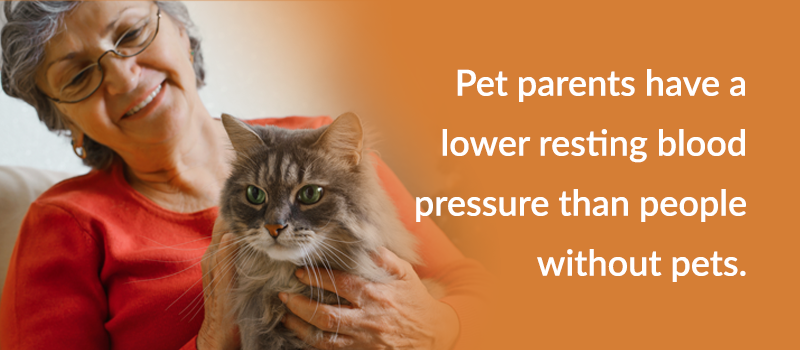
What Does the Data Show?
Again, HABRI has great data on the benefits of living — and exercising — with pets.
- Dog owners walk more than people who don’t have dogs, and approximately 60% of dog walkers meet recommendations for regular, moderate, and/or vigorous leisure‑time physical activity.
- A study of adults over age 50 with mildly elevated blood pressure showed that the presence of a pet dog or cat had a significant impact on blood pressure.
- Research that included more than 2,400 cat owners discovered they had a significantly lower relative risk of cardiovascular diseases, including stroke and heart attack, than people who didn’t have cats.
- People without cats have a 40% higher relative risk of heart attack than cat owners.
Pets and Aging
For seniors, pet ownership can have even more of an impact on mental and physical health.
Cardiovascular disease is the top cause of death in the United States. But living with pets can decrease the risk factors. In fact, the American Heart Association released a statement that confirms the connection between pets and preventing heart disease.
People with pets get more physical exercise than people without, which reduces stress, prevents obesity, and decreases the risk of long-term diseases such as Alzheimer’s and other causes of dementia.
Animal-assisted therapy has also been shown to help hospital patients with pain management and improve interactions with medical personnel.
The Data on Pets and Aging
- Older adults who live alone report feeling less lonely when they live with pets.
- A one-year study looked at the impact of animal-assisted therapy on people with chronic pain and found that patients reported less pain, discomfort, and stress; nursing staff also reported less stress.
- A study of older adults with mental illness living in long‑term care facilities concluded that animal-assisted therapy reduced depressive symptoms and improved cognitive function.
Trained Assistance
In addition to providing the feeling of unconditional love and companionship, some animals are trained to assist people with physical disabilities. They can help people with visual impairments to navigate in the world. They are trained to help open cupboards, contact emergency services, and perform other astonishing feats.
An organization called Medical Service Dogs trains and donates dogs to people in need. Dogs can help people with mobility issues by helping them to retrieve objects they have dropped. Because of their superior sense of smell, dogs can detect and alert people with diabetes that they have low blood sugar. They can predict seizures and assist people who have experienced a traumatic brain injury. And many military veterans have found comfort and assistance with service dogs trained to help them manage symptoms of PTSD.
Physical Challenges in Caring for Your Pets
Dogs and cats can perform many duties for humans, but there are times and situations when it can become difficult to care for a pet. For some people, it can be tricky if a large dog develops hip problems or other mobility issues. You need a lot of strength to help a big dog with mobility problems get outdoors to relieve themselves. Also, some people can get hurt if a large dog pulls on their leash. And anytime we have physical injuries or chronic conditions, difficult indoor and outdoor activities can make owning a dog (or any pet) a challenge.
Professional Assistance
There are a host of professionals who can help you interact in fun ways with your pet. No matter what the issue is, animal behaviorists and professional trainers have likely seen it and can teach you techniques that help both you and the animal. For example, some dogs that need extra mental and physical stimulation might benefit from agility training, where they are taught to climb, jump, and navigate around unfamiliar objects.
Before considering more drastic options, it’s always a good idea to consult a credentialed trainer.
When Keeping a Pet Becomes Unmanageable
It’s difficult to reach a time in your life when your situation doesn’t enable you to take care of your pet. If it comes to that, you might have to talk to friends, neighbors, or family about rehoming your animal. The benefit to this is that you can still visit them. Some nonprofit shelters or other rescue organizations will help rehome pets too.
When all the other options have been exhausted, some people surrender their pets to shelters or foster agencies.
We believe that quality of life outweighs the length of life. That’s why we say that sometimes the kindest thing to do with some pets that are either unhealthy, injured, or particularly dangerous is to consider euthanasia.
It’s unfair to give away a pet to someone if your pet has an expensive health problem, such as illness, injury, or dangerous behavior problems, unless they know in advance of their medical, surgical, or behavioral needs. And not all shelters or other rescue organizations have the resources to cover necessary veterinary or behavioral care.
No person should live with a dangerous animal or expose others to their dangerous pet. Also, a dangerous animal can be fearful and distrustful of people, leading them to live a poor quality of life moving from one unfamiliar living situation to another.
Subscribe to our eNewsletter
Keeping Pets and People Together
Keeping pets and people together is not only the kind thing to do, it also reduces pressure on an overburdened shelter system.
Too many people feel they have no option except to drop a pet off at an animal shelter. A 2018 survey by the National Council on Pet Population Study and Policy interviewed people at 12 shelters. They found that the top seven reasons for giving up cats and dogs were quite similar. Some of the top reasons people were relinquishing dogs to shelters included the following:
- They were moving (7%).
- Their landlord wouldn’t allow the pet (6%).
- The cost of maintaining a pet was too high (5%).
For cats, top reasons included:
- Too many animals in household (11%)
- Moving (8%)
- Landlord not allowing the cat (6%)
- Cost of pet maintenance (6%)
Interestingly, a high percentage of the animals (33% of dogs and 46.9% of cats) surrendered at shelters were young and were not spayed or neutered. This can lead to behavioral issues, which many people do not know how to handle. A full 96% of the dogs surrendered had not received adequate training to become a calm companion in the home or out on a walk in the neighborhood.
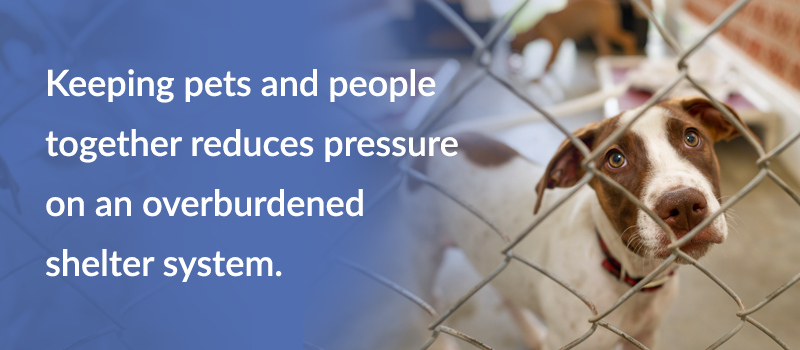
Why are so many pets going to shelters and never coming out? Sometimes people give up on pet ownership because they adopt or buy an animal without understanding how long the pet may live, and without fully considering the cost of care (food and veterinary care), the need for a pet sitter backup plan, and what it takes on a day‑to‑day basis to keep a pet healthy and happy.
Some pet parents experience unexpected health issues or financial difficulties. Most pets do best when they continue to live with the caregiver they are bonded to, but some circumstances make it difficult or not possible.
The COVID‑19 pandemic led to widespread job losses, deaths, and long‑term illnesses. Some pet parents found it difficult to care for their pets while keeping up with other essential expenses like rent and groceries. If people don’t have access to assistance or savings, they sometimes end up surrendering their pets to a shelter.
Because it is often difficult to find pet-friendly housing, the issues of affordable housing, landlords allowing pets, and providing for pets are all interrelated. As you may have heard, affordable housing is a social justice issue. And people with pets face an even more difficult situation. Know your rights as a renter, especially if you have a disability. Here in Ohio, there's a resource for those who are renting and live with a service or assistance animal based on Ohio Law. The laws may differ depending on where you live.
Even before the pandemic, more than 580,000 people were experiencing homelessness in the United States. It becomes extremely difficult to take care of pets while living on the streets or in a vehicle, especially while also caring for human family members.
Some veterinarians will advise clients who cannot afford veterinary care to take them to a shelter. Most shelters or other rescues will only help homeless pets. However, that is not a solution to the systemic problems that make it harder for low-income people to keep pets.
Thankfully, the animal welfare community is beginning to help people who want to keep their pets and simply need support caring for them. But there aren't enough of these organizations doing this work to maintain the human-animal bond.
Instead, we look for solutions that are rooted in the belief that everyone deserves to have a loving relationship with a pet. Most pet parents want to keep their animals and provide them with the necessary veterinary care. They simply need the financial resources to do so. That’s what organizations like ours are doing.
Shelters and Overpopulation
There is no single organization charged with keeping track of how many animals are living in shelters or how many are euthanized, but the numbers we have are always shocking. The American Society for the Prevention of Cruelty to Animals (ASPCA) estimates that:
- Approximately 6.3 million companion animals enter shelters in the U.S. every year.
- 3.1 million are dogs, and 3.2 million are cats.
- Each year, approximately 920,000 shelter animals are euthanized (390,000 dogs and 530,000 cats).
The good news is that the euthanasia numbers are going down, and adoptions are up — especially since the pandemic. One unfortunate side effect may be that more puppies and kittens were born as people recognized a demand for pets as people were spending more time at home.
Like all businesses, veterinarians had to manage and sometimes limit their practices to keep their staff, clients, and pet patients safe. That led to a problem of people not being able to spay or neuter their pets due to lack of open appointments at veterinary clinics, leading to unwanted pet pregnancies and increasing the number of unwanted pets.
How can we help keep the population of unwanted animals down and allow more families to keep living with their beloved pets?
Making a Difference in Your Community
A movement of nonprofit organizations, shelters, humane organizations, and veterinarians is growing to address the problems faced by struggling pet parents. They are recognizing that access to veterinary care is a social justice issue.
The American Veterinary Medical Association (AVMA) reported an increased need for affordable veterinary care due to the pandemic. Even before the pandemic, AVMA members were part of the Access to Veterinary Care Coalition (AVCC), which brought together professionals in 2016 who wanted to end disparities in access to veterinary care. Through their work, they released a report two years later called “Access to Veterinary Care: Barriers, Current Practices, and Public Policy,“ which was distributed to help veterinarians, animal welfare organizations, policymakers, and community leaders understand the ways that increasing access to veterinary care helps improve our communities.
Here are a few ways for anyone to get involved in this important issue.
Donate to Nonprofit Organizations
A healthy ecosystem of nonprofit organizations has been growing to address different facets of the problem. One of the best things you can do is to support these organizations by donating or volunteering. The following types of organizations are all doing their part to reduce pet homelessness and help struggling pet parents:
- Shelters, foster groups, and other rescue organizations
- Humane organizations
- Spay/neuter clinics
- Funds for low-income pet parents
- Funds for veterinary care other than spay/neuter procedures
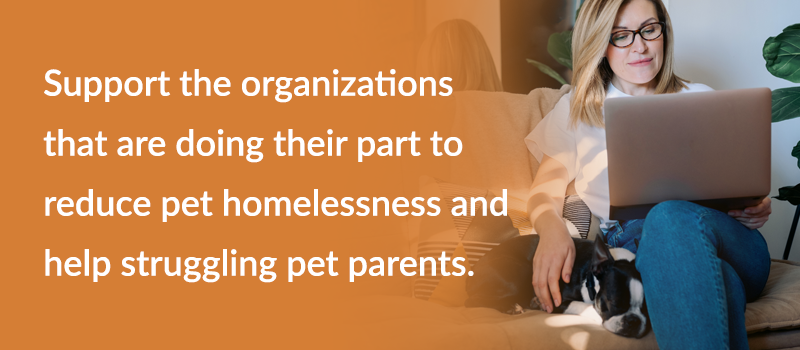
Use GuideStar to Research Nonprofits
Some people worry that an organization asking for donations might not be legitimate. Are they doing what they promise to do?
The website GuideStar.org is a good place to start your research. There are several types of nonprofits that can be found on the GuideStar site, including:
- Private charities
- Public charities
- Membership organizations
- Religious organizations
Anyone can access the general information, such as the organization’s logo, mission, and basic financial information, without signing in. Sometimes organizations won’t have financial information posted. For example, religious organizations are not required to report their financial information to the government. Look to see if they’re required to fill out an IRS Form 990 or 990-EZ.
Not every legitimate nonprofit takes the time to fill out the information in GuideStar, so even if you don’t see much information there, it could still be still a legitimate nonprofit.
If you’re really curious about a particular organization, you can uncover more information by signing up for a free account. Then you can find copies of their IRS Form 990, which is full of information. It’s a lengthy document, and the font is small, so be prepared before you read them.
The data and narratives in an IRS Form 990 are provided directly by a nonprofit staff member or volunteer representing that organization. They should be prepared by an independent accountant who’s trained in nonprofit accounting and accurately reporting the amount of funds that are used for programs, management & general, or fundraising, otherwise known as functional expenses. We’re wary of nonprofits that report 100% of funds go towards programs in their Form 990.
Having begun your research with GuideStar, you can start developing relationships with organizations that do the work in your community.
Volunteer in Your Community
If you really connect with a nonprofit organization in your community, one of the best ways to fully engage with their mission is by volunteering.
Many nonprofits rely on volunteers, but volunteers are becoming scarce. Sustainable nonprofits need money to pay for professional staff. They also need a diverse and connected board of directors that can help raise awareness of their organizational mission.
Volunteering and raising funds are deeply connected because the more people who understand the mission and what the contributions do, the more an organization grows.
At One Health Organization, we are always looking for volunteers with nonprofessional and professional backgrounds to help with fundraising, marketing/writing, event planning and coordination, and networking.
Local humane organizations, shelters, rescues, and spay/neuter organizations are also great places for animal lovers to volunteer. Nonprofits that work directly with animals will likely require training and other requirements to be compliant with the law and increase safety for volunteers and humane care of the animals.
The Human–Animal Bond
Humans have co-evolved with dogs and cats, and our relationship with domesticated animals goes back thousands of years. Many of us are familiar with the joy, the companionship, and the challenges of pet ownership.
Living with pets improves our mental, physical, and emotional health. And yet, some of the people who would most benefit from these nourishing relationships face barriers — especially financial and housing‑related — to keeping their pets in their homes.
Even the Centers for Disease Control and Prevention (CDC) understands the importance of pet health to keep people healthy. Now, many types of physicians are asking their patients about pets that live in their homes, which often opens up more information about a patient’s overall health and well-being.
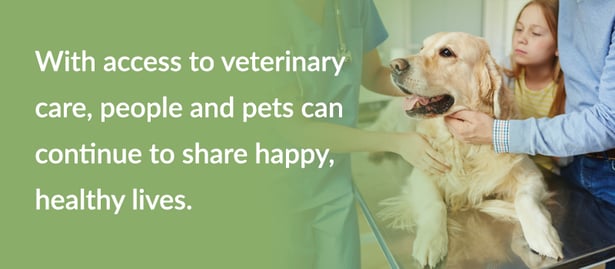
All of the above is why we believe that access to veterinary care is a social justice issue, and is one critical reason why we exist.
We want to reduce the barriers that currently exist in accessing veterinary care. Together, we can work to ensure that people and pets continue to share happy, healthy lives.
